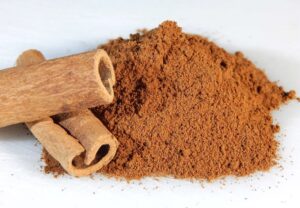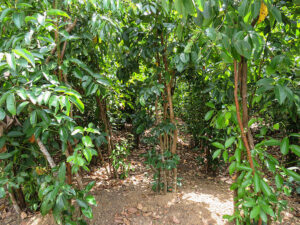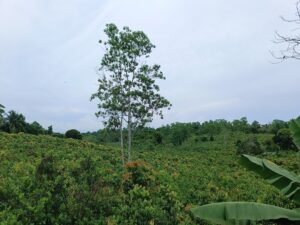Ceylon Cinnamon History
What is the History of Cinnamon?
Cinnamon, a prized spice that has captured the imagination of civilizations for centuries, holds a captivating history. Its origins can be traced back to ancient times, and it has been highly regarded for its various uses and health benefits. Let’s delve into the intriguing story of cinnamon.
Cinnamon’s journey through history dates back thousands of years. It was particularly valued in the Middle East, where its medicinal properties were cherished. Even in ancient Egypt, as early as 2000 BCE, cinnamon found its place of honor. Its aromatic essence was mentioned in the Bible, in Proverb 7:17, as it says, “I have sprinkled my bed with myrrh, aloes, and cinnamon.” This reference showcases the long-standing appreciation of cinnamon and its role in enhancing daily life.
The true origin of cinnamon remained a mystery for a significant period. Traders deliberately concealed its source, adding an air of intrigue to this remarkable spice. However, over time, it became widely known that cinnamon originated from the tiny island of Sri Lanka, located at the tip of India. Sri Lanka emerged as the true home of cinnamon, known as Ceylon Cinnamon.
The history of cinnamon further intertwines with ancient rituals and traditions. In the Hebrew Bible and Talmud, cinnamon played a crucial role in the consecrated incense known as the Ketoret. The incense, consisting of various ingredients, including cinnamon, was offered on the specialized incense altar during the time when the Tabernacle was situated in the First and Second Jerusalem Temples. The Ketoret held great significance in the Temple service, highlighting cinnamon’s value in religious practices.
Cinnamon’s reputation as a prized commodity extended beyond religious contexts. It was highly sought after among ancient nations and regarded as a gift fit for monarchs and even deities. Historical records mention the gifting of cinnamon and cassia to the temple of Apollo at Miletus, emphasizing its exceptional worth. Notable classical writers like Herodotus made references to cinnamon, further solidifying its status as a cherished spice.
Cinnamon’s scarcity and exotic nature made it a symbol of luxury. In ancient Rome, it was considered too valuable to be commonly used on funeral pyres. However, the Emperor Nero’s extravagant display of wealth and grief led to the burning of a year’s worth of cinnamon at his wife Poppaea Sabina’s funeral in AD 65.
Cinnamon’s route to Europe was an intriguing one. Before the foundation of Cairo, Alexandria served as the Mediterranean shipping port for cinnamon. European traders, influenced by the writings of Latin authors quoting Herodotus, were aware that cinnamon arrived through the Red Sea to the trading ports of Egypt. However, the exact origin, whether from Ethiopia or elsewhere, remained ambiguous. Accounts from the time, such as the one by Sieur de Joinville in 1248, described cinnamon as being fished up in nets at the source of the Nile, believed to be located at the edge of the world.
Throughout the Middle Ages, the origin of cinnamon remained a mystery in the Western world. Renowned explorer Marco Polo, while sharing tales of his travels, deliberately avoided revealing specific details about cinnamon’s source. Ancient stories persisted, with Arabia being considered the birthplace of cinnamon. Legends told of giant Cinnamon birds that collected the sticks from a mysterious land where cinnamon trees grew, using them to construct their nests. Arab traders employed ingenious methods to obtain the highly sought-after spice. These stories persisted until as late as 1310 in Byzantium, even though Pliny the Elder had debunked the myths in the first century, attributing them to traders’ attempts to inflate prices.
It wasn’t until the 13th century that the first mentions of cinnamon’s growth in Sri Lanka appeared in Zakariya al-Qazwini’s Athar al-bilad wa-akhbar al-‘ibad (“Monument of Places and History of God’s Bondsmen”). Shortly after, in around 1292, John of Montecorvino referred to the spice in a letter. Indonesian traders transported cinnamon, known as “kayu manis” or “sweet wood,” from the Moluccas to East Africa along the renowned “cinnamon route.” From there, local traders facilitated its journey to the Roman market. Arab traders utilized overland trade routes to bring cinnamon to Alexandria, Egypt, where Venetian traders from Italy monopolized the spice trade in Europe. However, the rise of other Mediterranean powers, such as the Mamluk Sultans and the Ottoman Empire, disrupted this trade, prompting Europeans to explore alternative routes to Asia.
Dutch traders eventually emerged as key players in the cinnamon trade. They allied with the Kingdom of Kandy, located inland in Ceylon (Sri Lanka), and established a trading post in 1638. By 1640, they had gained control of cinnamon factories and expelled the remaining Portuguese presence by 1658. Ceylon’s shores were abundant with cinnamon, and the Dutch marveled at its superior quality, asserting that its aroma could be sensed even eight leagues out to sea when the wind blew from the island. The Dutch East India Company revolutionized cinnamon harvesting methods, eventually cultivating their own cinnamon trees.
Where to Buy Ceylon Cinnamon?
If you’re eager to experience the exquisite flavor and numerous benefits of Ceylon Cinnamon, you may wonder where to buy this exceptional spice. With its increasing popularity and global recognition, Ceylon Cinnamon is now available in various forms, ensuring that consumers can enjoy its unique qualities.
Local Spice Stores: Many specialty spice stores carry Ceylon Cinnamon, allowing you to explore its aromatic delights. Check your local area for stores specializing in high-quality spices and inquire about their selection.
Online Retailers: The convenience of online shopping offers an extensive range of options for purchasing Ceylon Cinnamon. Reputable online retailers provide access to a wide variety of cinnamon products, including Ceylon Cinnamon powder, sticks, capsules, and extracts.
Farmers Markets: Visiting farmers markets can be an enriching experience, where you can find local vendors offering authentic and natural products. Look for spice vendors who emphasize the quality and origin of their cinnamon.
Health Food Stores: Health food stores often stock premium-grade spices, including Ceylon Cinnamon. These stores prioritize organic and natural products, making them a reliable source for finding this remarkable spice.
Ceylon Cinnamon Scientific Name and Family
Ceylon Cinnamon, scientifically known as Cinnamomum verum, belongs to the Lauraceae family. Also referred to as “true cinnamon,” it is distinct from Cassia cinnamon, which belongs to the Cinnamomum cassia family. The unique properties and delicate flavor of Ceylon Cinnamon set it apart, making it highly sought after by spice enthusiasts and health-conscious individuals alike.
Ceylon Cinnamon Side Effects
While Ceylon Cinnamon offers a range of health benefits, it is essential to be aware of potential side effects. Like any spice or food, consuming excessive amounts of cinnamon may have adverse effects on certain individuals. Some potential side effects of Ceylon Cinnamon include:
Allergic Reactions: Some people may be allergic to cinnamon and experience symptoms such as skin rash, itching, or swelling. If you have known allergies, it is advisable to consult a healthcare professional before incorporating cinnamon into your diet.
Coumarin Sensitivity: Coumarin, a natural compound found in cinnamon, may cause adverse effects in large quantities. Cassia cinnamon, in particular, contains higher levels of coumarin compared to Ceylon Cinnamon. Individuals with liver conditions or taking specific medications should exercise caution when consuming large amounts of cinnamon.
To minimize the risk of adverse effects, it is recommended to consume cinnamon in moderation and opt for Ceylon Cinnamon, known for its lower coumarin content.
Ceylon Cinnamon Powder: A Versatile and Flavorful Spice
Ceylon Cinnamon powder is a versatile and convenient form of this beloved spice. With its fine texture and rich aroma, it can be easily incorporated into various recipes and culinary creations. Here are some popular uses of Ceylon Cinnamon powder:
Culinary Delights: Sprinkle Ceylon Cinnamon powder on oatmeal, yogurt, or fruit for a delightful flavor boost. It pairs well with baked goods, such as cookies, cakes, and pies. Experiment with adding a dash of cinnamon to savory dishes like curries or roasted vegetables for a unique twist.
Warm Beverages: Add a pinch of Ceylon Cinnamon powder to your morning coffee, hot chocolate, or tea for a comforting and aromatic experience. It blends seamlessly with warm beverages, infusing them with its enticing flavor.
Spice Blends: Create your own spice blends by incorporating Ceylon Cinnamon powder with other complementary spices. It adds depth and complexity to blends used in rubs, marinades, or spice mixes for meat, poultry, or vegetables.
Health Tonics: Harness the potential health benefits of Ceylon Cinnamon by incorporating it into homemade health tonics or wellness drinks. Combine it with other beneficial ingredients like honey, lemon, or ginger for a revitalizing beverage.
Cinnamon Tree: The Source of Ceylon Cinnamon’s Delight

The cinnamon tree, scientifically known as Cinnamomum verum, is the true source of Ceylon Cinnamon. It belongs to the Lauraceae family of evergreen trees and is native to Sri Lanka. The cinnamon tree can reach heights of up to 15 meters, with leathery leaves and small, inconspicuous flowers. Its inner bark is carefully harvested and dried to produce the delicate cinnamon quills or sticks cherished for their distinct flavor and aroma.
Ceylon Cinnamon vs. Cinnamon: Unveiling the Differences
Ceylon Cinnamon and common cinnamon, often referred to as Cassia cinnamon, differ in several aspects. Let’s explore the primary differences between the two:
Flavor: Ceylon Cinnamon boasts a delicate, subtly sweet flavor with citrusy undertones. On the other hand, Cassia cinnamon possesses a stronger, more robust flavor profile with a spicy and slightly bitter taste.
Coumarin Content: Coumarin, a naturally occurring compound found in cinnamon, may be a concern when consumed in excessive amounts. Ceylon Cinnamon has significantly lower levels of coumarin compared to Cassia cinnamon, making it a safer choice for those who consume cinnamon regularly or in larger quantities.
Appearance: Ceylon Cinnamon sticks have a thin and delicate texture with multiple layers, while Cassia cinnamon sticks are thicker and have a rougher texture. The difference in appearance aids in distinguishing between the two types of cinnamon.
When selecting cinnamon, consider your personal preferences, intended use, and any specific health considerations to choose the most suitable variety for your needs. Ceylon Cinnamon, with its nuanced flavor and lower coumarin content, offers a premium option for those seeking a high-quality cinnamon experience.

In conclusion, the fascinating history of cinnamon unveils its significance across ancient civilizations. Ceylon Cinnamon, scientifically known as Cinnamomum verum, stands out for its delicate flavor, numerous health benefits, and lower coumarin content compared to Cassia cinnamon. Whether you’re exploring its rich history, purchasing this exceptional spice, or understanding its scientific name and family, cinnamon continues to captivate with its enticing aroma and versatile applications. Embrace the allure of Ceylon Cinnamon and savor its remarkable qualities in your culinary endeavors and wellness pursuits.
